Experimental Investigation on the Impact of Tungsten Carbide Reinforcement on the Mechanical Properties of Sisal-Fiber-Reinforced Composites †
Abstract
1. Introduction
2. Material Preparation
2.1. Material Preparation
2.2. Flexural Test
- σ_f: flexural strength (MPa or psi);
- F: maximum load applied (N or lb);
- L: span length (mm or inches);
- b: specimen width (mm or inches);
- h: specimen thickness (mm or inches).
3. Result and Discussion
3.1. Flexural Test
3.2. Impact Test
3.3. SEM Analysis
4. Conclusions
Author Contributions
Funding
Institutional Review Board Statement
Informed Consent Statement
Data Availability Statement
Conflicts of Interest
References
- Zhang, N.; Gao, Y.; Sheng, K.; Jing, W.; Xu, X.; Bao, T.; Wang, S. Effective extraction of fluoroquinolones from water using facile modified plant fibers. J. Pharm. Anal. 2022, 12, 791–800. [Google Scholar] [CrossRef] [PubMed]
- Manimaran, P.; Senthamaraikannan, P.; Sanjay, M.R.; Marichelvam, M.K.; Jawaid, M. Study on characterization of Furcraea foetida new natural fiber as composite reinforcement for lightweight applications. Carbohydr. Polym. 2018, 181, 650–658. [Google Scholar] [CrossRef] [PubMed]
- Faruk, O.; Bledzki, A.K.; Fink, H.-P.; Sain, M. Biocomposites reinforced with natural fibers: 2000–2010. Prog. Polym. Sci. 2012, 37, 1552–1596. [Google Scholar] [CrossRef]
- Raju, P.; Raja, K.; Lingadurai, K.; Maridurai, T.; Prasanna, S.C. Mechanical, wear, and drop load impact behavior of glass/Caryota urens hybridized fiber-reinforced nanoclay/SiC toughened epoxy multihybrid composite. Polym. Compos. 2021, 42, 1486–1496. [Google Scholar] [CrossRef]
- Balla, V.K.; Kate, K.H.; Satyavolu, J.; Singh, P.; Tadimeti, J.G.D. Additive manufacturing of natural fiber reinforced polymer composites: Processing and prospects. Compos. Part B Eng. 2019, 174, 106956. [Google Scholar] [CrossRef]
- Nair, A.B.; Joseph, R. Chemistry, Manufacture and Applications of Natural Rubber; Kohjiya, S., Ikeda, Y., Eds.; Woodhead Publishing: Sawston, UK, 2014; pp. 249–283. [Google Scholar]
- Li, X.; Tabil, L.G.; Oguocha, I.N.; Panigrahi, S. Thermal diffusivity, thermal conductivity, and specific heat of flax fiber-HDPE biocomposites at processing temperatures. Compos. Sci. Technol. 2008, 68, 1753–1758. [Google Scholar] [CrossRef]
- Mittal, V.; Saini, R.; Sinha, S. Natural fiber-mediated epoxy composites—A review. Compos. Part B Eng. 2016, 99, 425–435. [Google Scholar] [CrossRef]
- Dhas, D.S.E.J.; Velmurugan, C.; Wins, K.L.D. Investigations on the Effect of Tungsten Carbide and Graphite Reinforcements during Spark Erosion Machining of Aluminium Alloy (AA 5052) Hybrid Composite. Silicon 2018, 10, 2769–2781. [Google Scholar] [CrossRef]
- Fenghong, C.; Chang, C.; Zhenyu, W.; Muthuramalingam, T.; Anbuchezhiyan, G. Effects of Silicon Carbide and Tungsten Carbide in Aluminium Metal Matrix Composites. Silicon 2019, 11, 2625–2632. [Google Scholar] [CrossRef]
- Govindarajan, V.; Sivakumar, R.; Patil, P.P.; Kaliappan, S.; Kumar, T.C.A.; Kannan, M.; Ramesh, B. Effect of Tungsten Carbide Addition on the Microstructure and Mechanical Behavior of Titanium Matrix Developed by Powder Metallurgy Route. Adv. Mater. Sci. Eng. 2022, 2022, 2266951. [Google Scholar] [CrossRef]
- Dhanesh, S.; Kumar, K.S.; Fayiz, N.K.M.; Yohannan, L.; Sujith, R. Recent developments in hybrid aluminium metal matrix composites: A review. Mater. Today Proc. 2021, 45, 1376–1381. [Google Scholar] [CrossRef]
- Panneerselvam, T.; Kandavel, T.K.; Sreenivas, S.A.; Karthik, S.; Andru, M.M. Effects of Working Parameters on Performance Characteristics of Cutting Tools Processed through Powder Metallurgy under Turning Operation. J. Mater. Eng. Perform. 2021, 30, 2890–2898. [Google Scholar] [CrossRef]
- Kishore, P.; Kumar, P.M.; Dinesh, D. Wear analysis of Al 5052 alloy with varying percentage of tungsten carbide. AIP Conf. Proc. 2019, 2128, 040003. [Google Scholar]
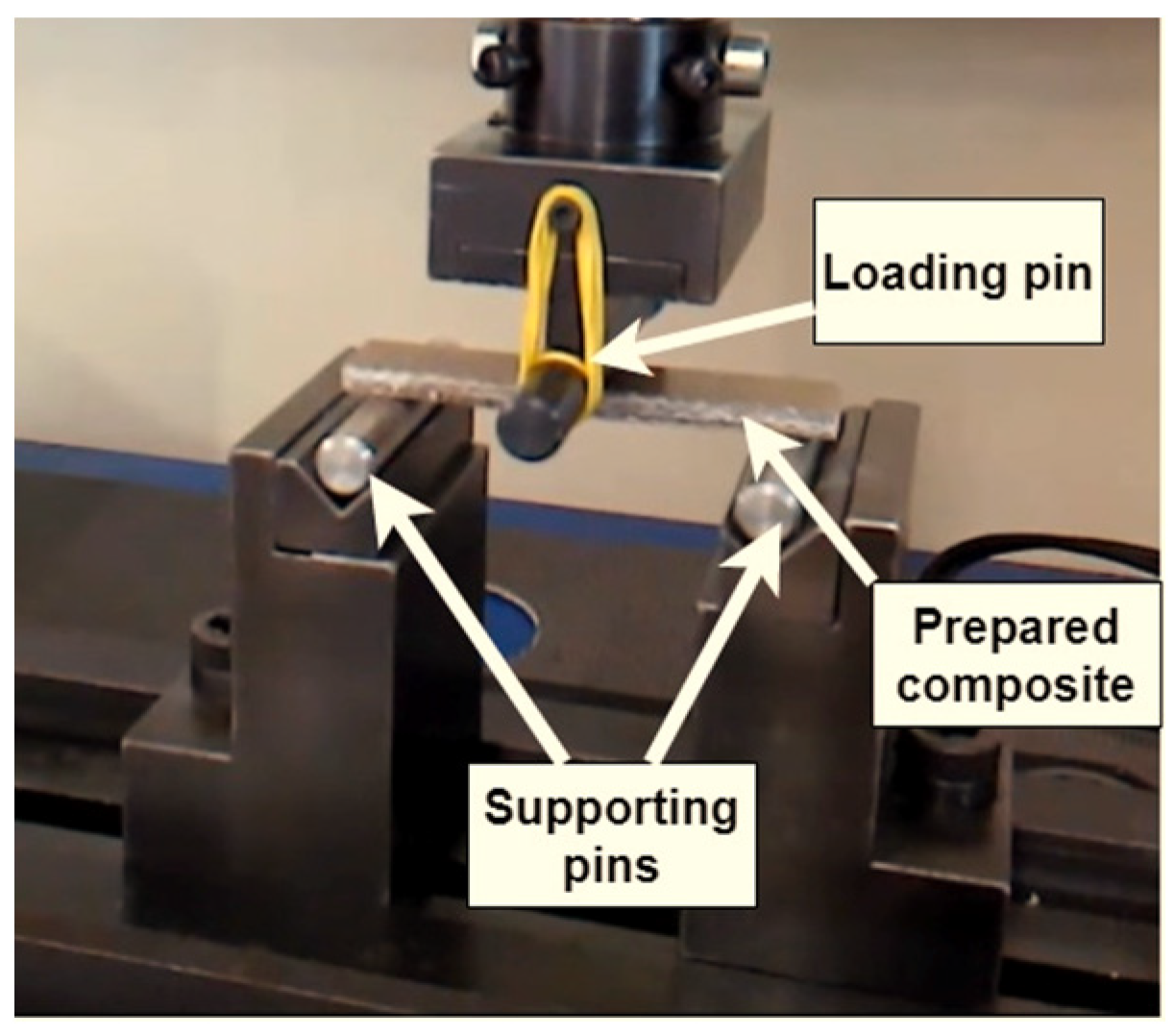
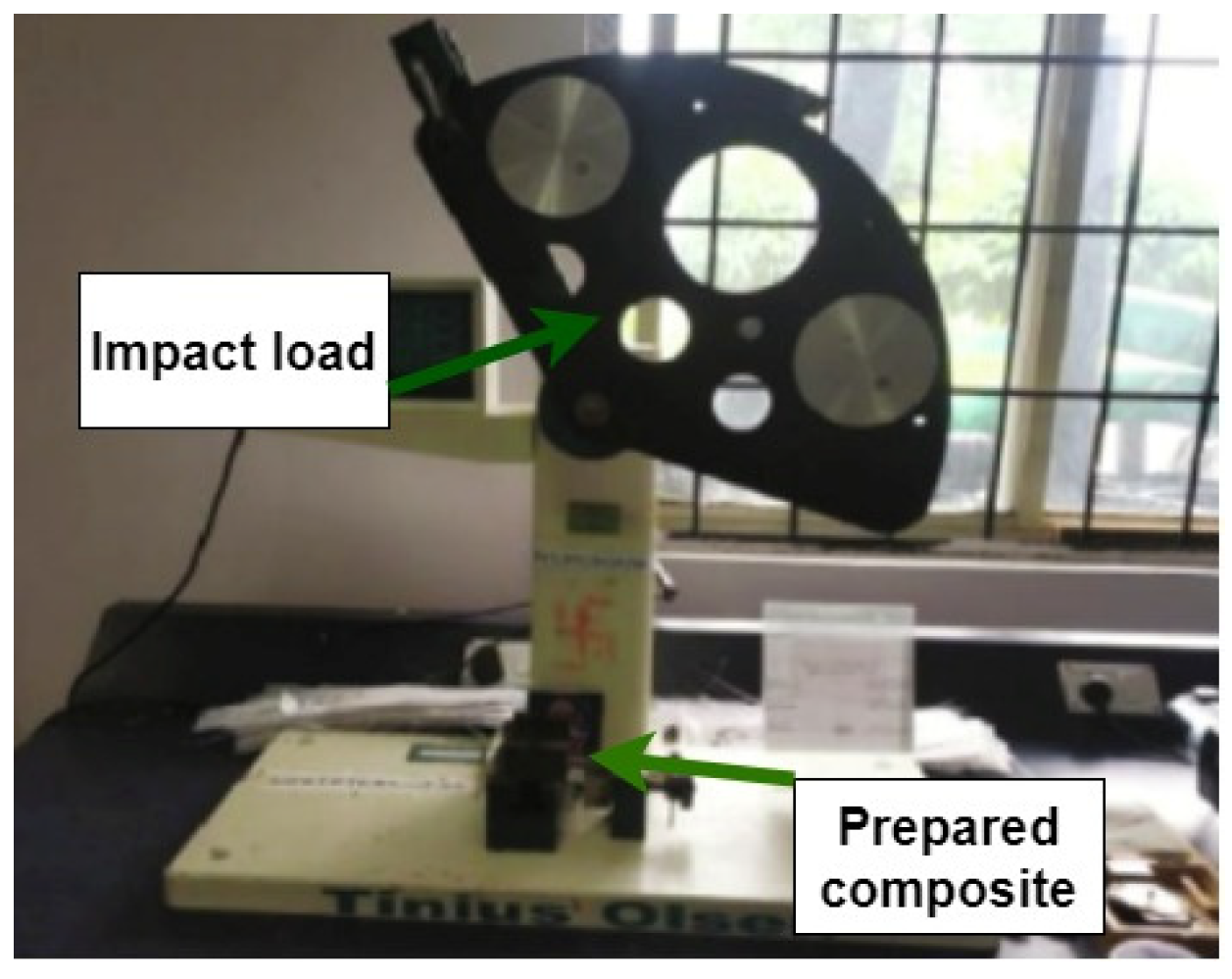
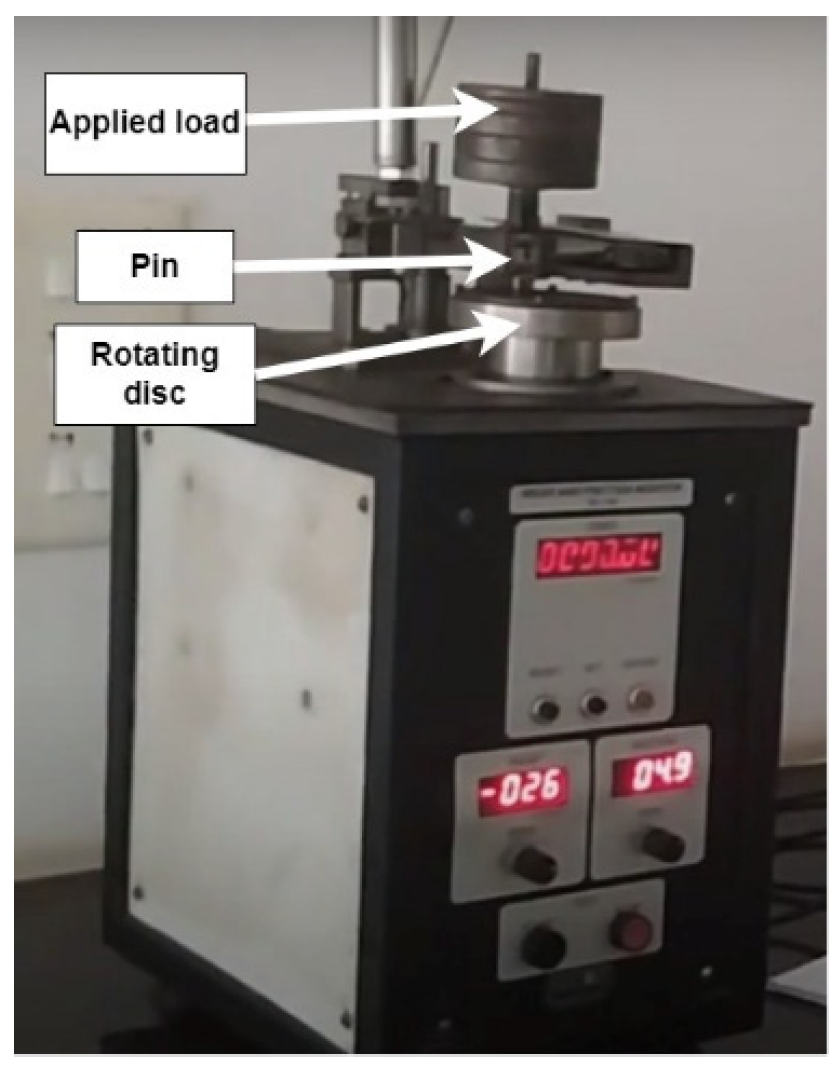
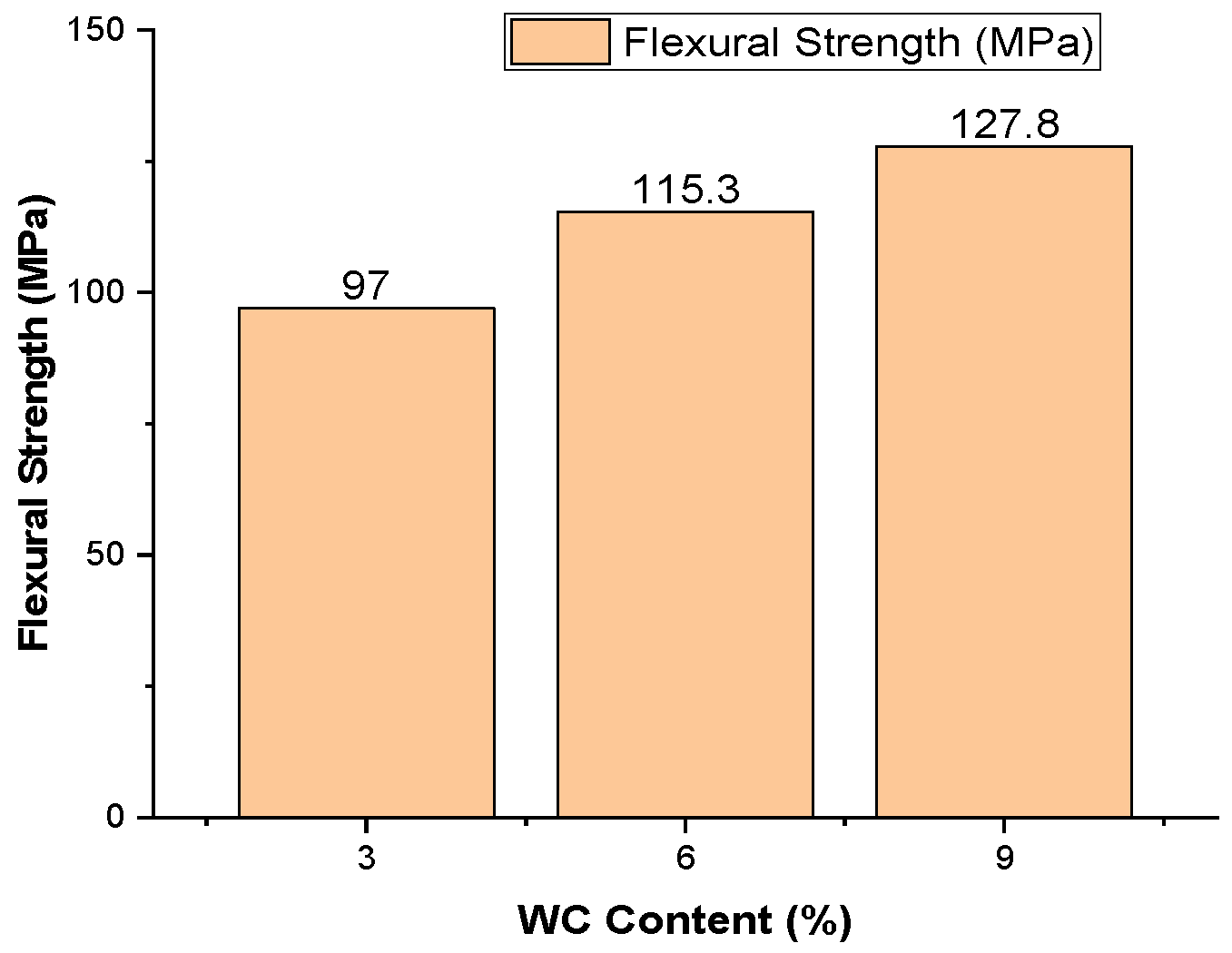

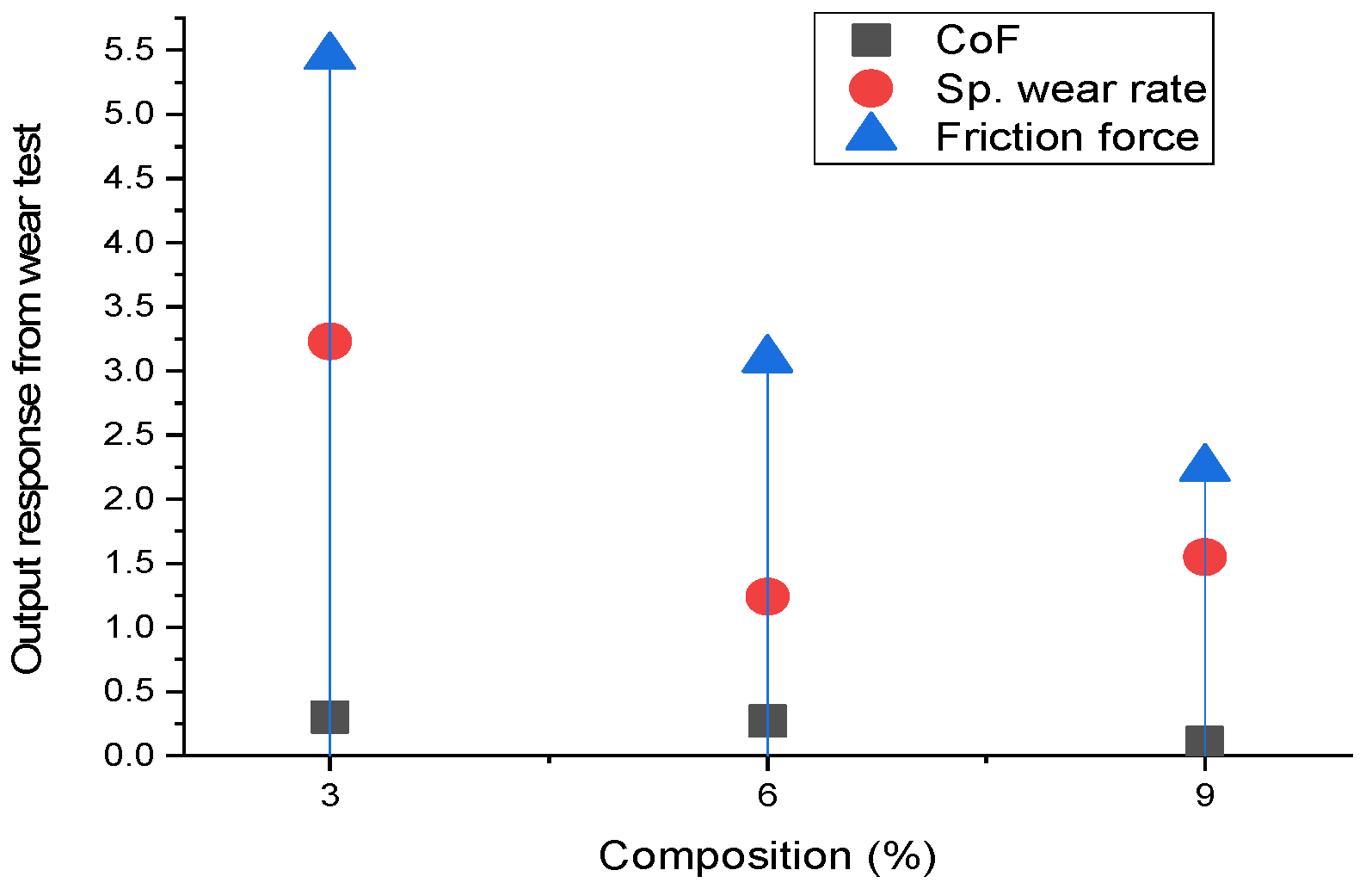

| Composite Composition | Sisal Fiber (%) | Epoxy Resin (%) | WC Nanoparticles (%) |
|---|---|---|---|
| Composite 3% WC | 40% | 57% | 3% |
| Composite 6% WC | 40% | 54% | 6% |
| Composite 9% WC | 40% | 51% | 9% |
| WC Content (%) | Impact Strength (J/m) |
|---|---|
| 3 | 520.34 |
| 6 | 544.3 |
| 9 | 573.44 |
| WC Content (%) | Flexural Strength (MPa) |
|---|---|
| 3 | 97 |
| 6 | 115.3 |
| 9 | 127.8 |
| Composition (%) | Load (N) | Speed (RPM) | Sliding Distance (m) | COF | Sp. Wear Rate mm3/Nm | Friction Force (N) |
|---|---|---|---|---|---|---|
| 3 | 20 | 100 | 27.72 | 0.3 | 3.23 | 5.45 |
| 6 | 20 | 100 | 27.72 | 0.27 | 1.24 | 3.09 |
| 9 | 20 | 100 | 27.72 | 0.1 | 1.55 | 2.24 |
Disclaimer/Publisher’s Note: The statements, opinions and data contained in all publications are solely those of the individual author(s) and contributor(s) and not of MDPI and/or the editor(s). MDPI and/or the editor(s) disclaim responsibility for any injury to people or property resulting from any ideas, methods, instructions or products referred to in the content. |
© 2024 by the authors. Licensee MDPI, Basel, Switzerland. This article is an open access article distributed under the terms and conditions of the Creative Commons Attribution (CC BY) license (https://creativecommons.org/licenses/by/4.0/).
Share and Cite
Thirupathy, M.; Vadivel, M.; Subbiah, T.; Pathinettampadian, G. Experimental Investigation on the Impact of Tungsten Carbide Reinforcement on the Mechanical Properties of Sisal-Fiber-Reinforced Composites. Eng. Proc. 2024, 61, 40. https://doi.org/10.3390/engproc2024061040
Thirupathy M, Vadivel M, Subbiah T, Pathinettampadian G. Experimental Investigation on the Impact of Tungsten Carbide Reinforcement on the Mechanical Properties of Sisal-Fiber-Reinforced Composites. Engineering Proceedings. 2024; 61(1):40. https://doi.org/10.3390/engproc2024061040
Chicago/Turabian StyleThirupathy, Maridurai, Muthuraman Vadivel, Thirugnanam Subbiah, and Gurusamy Pathinettampadian. 2024. "Experimental Investigation on the Impact of Tungsten Carbide Reinforcement on the Mechanical Properties of Sisal-Fiber-Reinforced Composites" Engineering Proceedings 61, no. 1: 40. https://doi.org/10.3390/engproc2024061040
APA StyleThirupathy, M., Vadivel, M., Subbiah, T., & Pathinettampadian, G. (2024). Experimental Investigation on the Impact of Tungsten Carbide Reinforcement on the Mechanical Properties of Sisal-Fiber-Reinforced Composites. Engineering Proceedings, 61(1), 40. https://doi.org/10.3390/engproc2024061040






